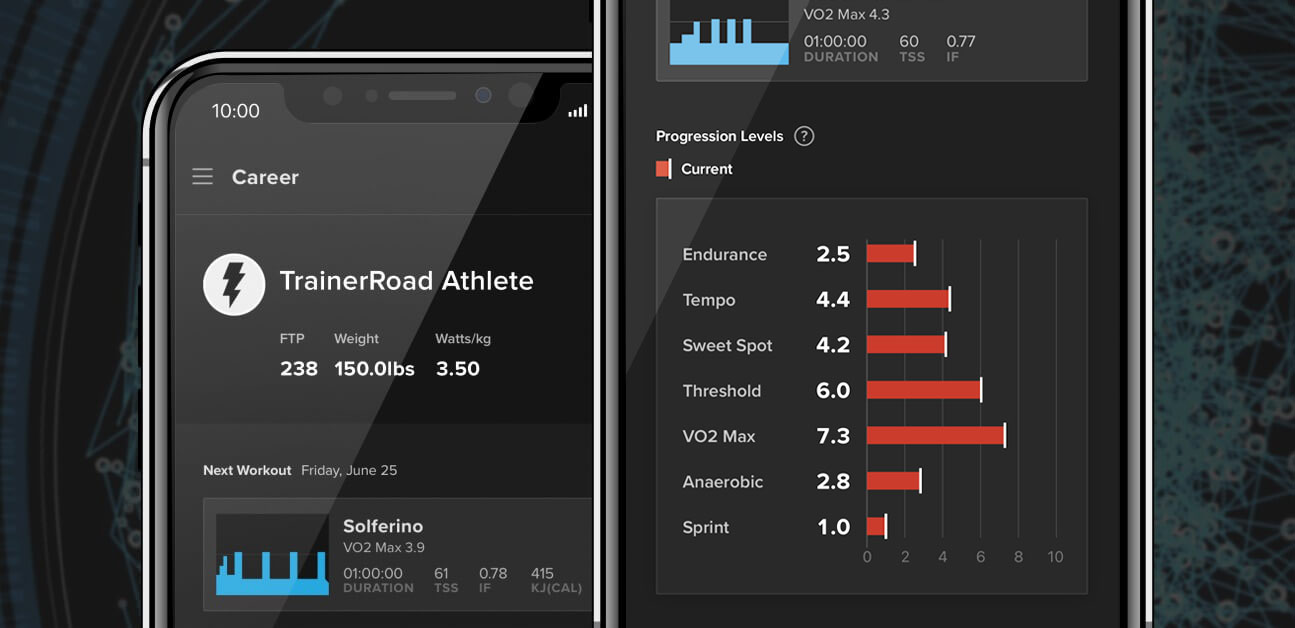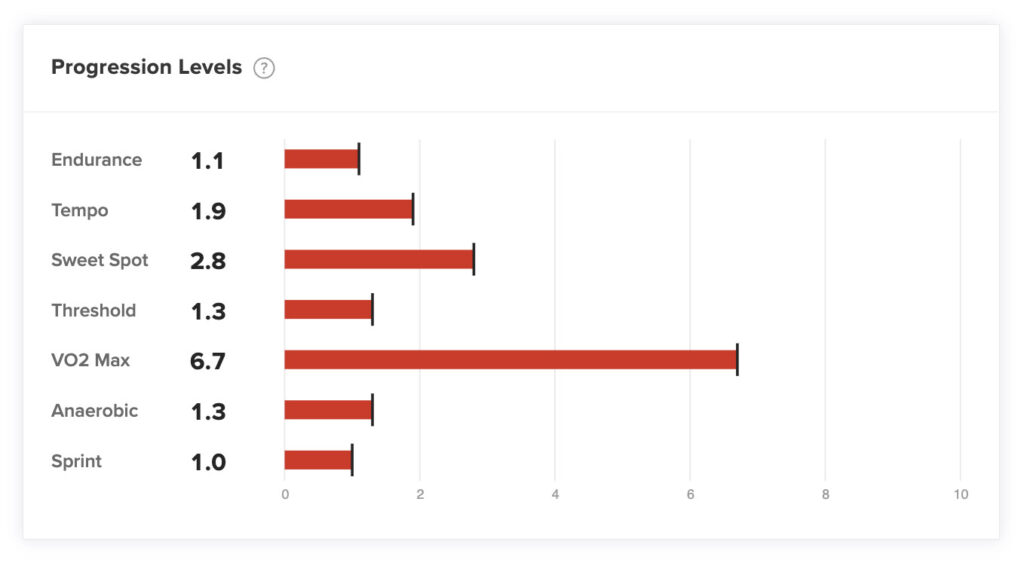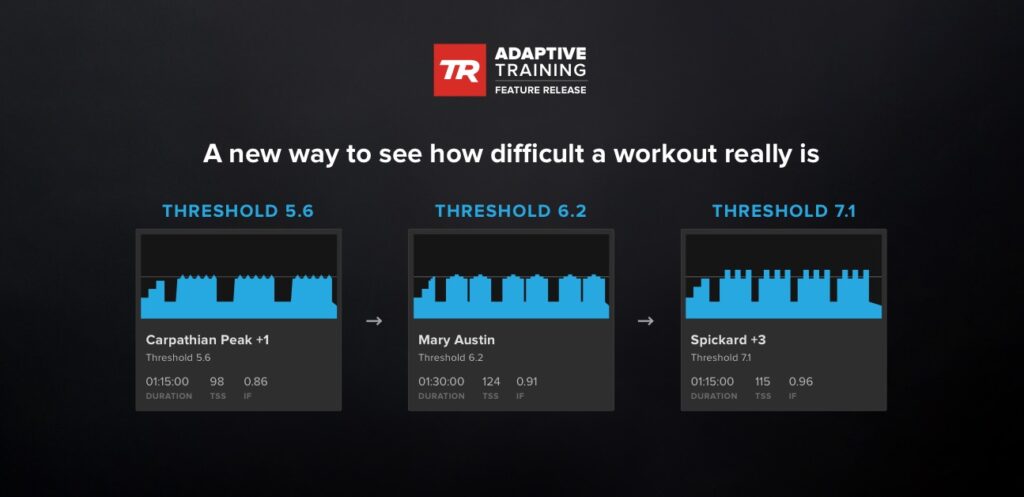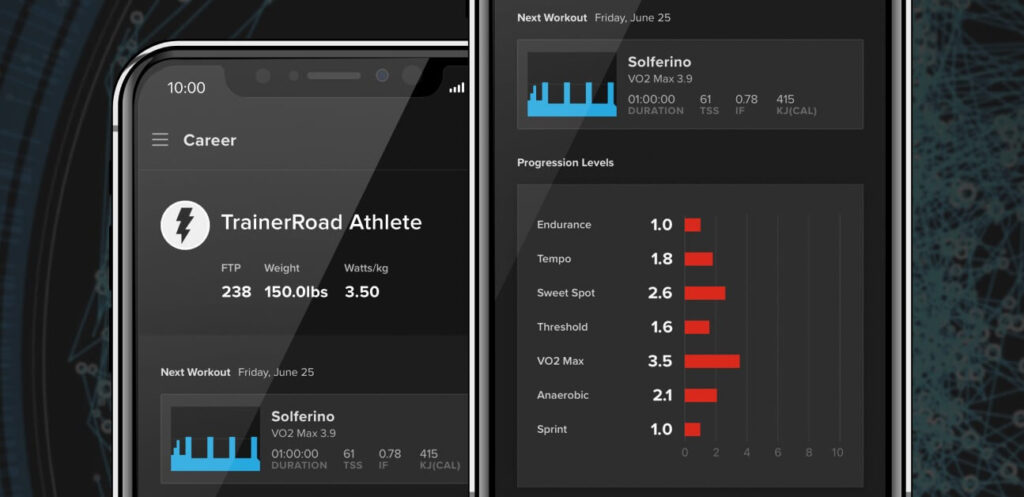Progression Levels: What They Are and How to Use Them

Functional Threshold Power (FTP) is a great way to measure overall cycling ability, but sometimes, your relative strengths and weaknesses can change, even while your FTP stays the same. That’s where Progression Levels come in, tracking your current capabilities in each power zone to monitor every aspect of your cycling fitness. Adaptive Training uses your Progression Levels to pick the right workouts to make you faster.
Sign Up Risk-Free for 30 Days
What Are Progression Levels?
In TrainerRoad, your unique range of cycling abilities is reflected in your Progression Levels, a dynamic metric that quantifies your fitness and training progress across seven power zones. As you train and your fitness subtly changes, your Progression Levels adjust to reflect those changes. Progression Levels help Adaptive Training give you the right workout each day, and provide insight into your abilities as they grow and change.

You’ll find seven Progression Levels on your career page (one level for every power zone). Each level is individually measured on a scale from one to ten, with one representing the baseline and ten representing the highest level of ability at any given FTP. In general, your Progression Levels will start out in the lower range as you begin a training block. As you progress through workouts and training weeks your Progression Levels will change to reflect your development in each zone.
Insights Beyond FTP
FTP is a powerful tool to see the big picture of your fitness and is still an excellent way to set the overall intensities of your workouts. But Progression Levels offer an additional level of detail, reflecting aspects of your fitness that may be overlooked by a broader view. Progression Levels track the specifics of your abilities at your current FTP, and let Adaptive Training personalize every workout to your unique needs. As a result, Progression Levels help make you faster than ever before!
What Affects Progression Levels?
Progression Levels adjust based on the relative difficulty of the workouts you complete, and on how successfully you complete them.
Workouts in TrainerRoad are categorized by difficulty and training zone with Workout Levels. Each time you complete a workout, Adaptive Training analyzes your performance. If you successfully complete a workout with a higher Level than your current Progression Level in that workout’s training zone, your Progression Levels will adjust upwards in response. Likewise, if you struggle with a workout, your Progression Levels may adjust downwards slightly to ensure your next workout in that zone is a bit easier.
Progression Levels also respond to FTP changes and time off. When you spend an extended period away from the bike, Progression Levels adjust to reflect the natural decline in performance that happens when you aren’t training, helping to keep your workouts productive when you do get back on the bike. Similarly, when your FTP increases your levels will adjust downwards in proportion, so your upcoming workouts aren’t suddenly more difficult.
The Benefits of Progression Levels
While Progression Levels are a complex calculation of many factors, using them couldn’t be simpler. Here are some benefits you can expect when you take advantage of Progression Levels
1. Get the Right Workouts
Progression Levels help inform Adaptive Training’s personalized adaptations. As you progress through your training plan, your workouts will adjust to match your Progression Levels, ensuring that every workout is right for your current fitness.
If you’re building a training plan or choosing workouts on the fly, Progression Levels can be a great tool, too. You can use the filters in the TrainerRoad workout library to find workouts that match your Progression Levels, and if you don’t want to go through the effort of manually choosing a workout, TrainNow uses your Progression Levels to inform its intelligent workout recommendations.
2. Understand Your Developing Fitness
With Progression Levels, you can thoroughly understand your fitness and how it’s changing. That way, when it comes to time to race, reach for a goal, or simply go out and conquer a big training ride, you’ll have a better understanding of your capabilities. Knowing how your abilities are developing in response to your training can help you grow your strengths and target limiters too.
3. Gain Insight Into Your Training Plan
Every TrainerRoad plan follows a specific progression, designed to develop the fitness you need to reach your goals. Checking your Progression Levels after each workout is an excellent way to gain insight into your progress through your training plan.
Adaptive Training
Get the right workout, every time with training that adapts to you.
Check Out TrainerRoadFor example, Sweet Spot Base includes lots of workouts that are designed to develop your sustained power capabilities. As a result, you’ll see more growth in your Endurance and Sweet Spot Progression Levels than your Anaerobic Capacity or VO2 Max Levels. Watching how quickly each Level changes can help you understand how you’re improving as you train.
Progression Levels FAQ
Q: Where Can I Find my Progression Levels?
You’ll find your Progression Levels on your TrainerRoad Career page, available on the TrainerRoad app and your online TrainerRoad account.
Q: Why Didn’t My Progression Levels Change After a Workout?
Your Progression Levels don’t always change after every workout. When your performance in a workout aligns with your current Progression Levels, those Progression Levels won’t change. That’s not a bad thing—it simply means the workout perfectly matched your current needs. When you do successfully complete a workout above your current Progression Level, your level will adjust to reflect your higher capabilities.
Q: Why Did my Progression Levels Adjust After a Ramp Test or FTP change?
Your FTP is a decisive factor in how challenging your workouts are relative to your abilities, and Progression Levels reflect the details of your fitness at your current FTP. That’s why when your FTP goes up, your Progression Levels adjust downward proportionately, preventing a sudden increase in workout intensity caused by a higher FTP. This makes your progression through your training plan smoother, more sustainable, and more effective.
Q: Why Didn’t My Progression Levels Change After My FTP went down?
If you complete an FTP test and your new FTP is lower than your previous FTP, your Progression Levels won’t change. A lower FTP naturally lowers the overall difficulty of your workouts, and Adaptive Training will lower your Progression Levels if you still have trouble completing workouts at your new FTP.


